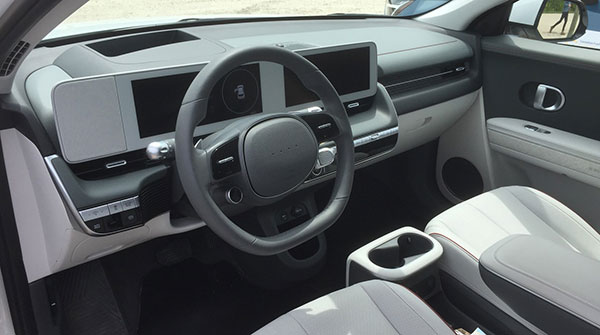
The Hyundai flagship IONIQ 5 SUV continues the legacy of electric excellence
 The IONIQ – the brand name for all-electric models from Hyundai – is quickly becoming known for excellent electric vehicles.
The IONIQ – the brand name for all-electric models from Hyundai – is quickly becoming known for excellent electric vehicles.
The IONIQ 7 – a full-size, three-row flagship SUV – is coming in 2024. It will have a tough act to follow after the unprecedented success of the IONIQ 5 and the IONIQ 6, both of which collected three major international awards. The IONIQ 5 won the World Car of the Year, World Electric Vehicle of the Year, and World Car Design of the Year last year; this year, the IONIQ 6 swept the three same awards, and Hyundai became the first automaker ever to score three back-to-back honours. Only one other vehicle – the Jaguar I-Pace in 2019 – has collected three awards in the same year. The awards are voted on by 100 automotive journalists from 32 countries.
In Canada, the IONIQ 5 was named the EV of the year in the Automobile Journalists Association of Canada (AJAC) car of the year awards, as well as the Canadian utility vehicle of the year.
|
|
|
|
| Related Stories |
| Short-term test of the long-range, all-electric IONIQ 6
|
| Plenty right with the Hyundai Ioniq 5 – if you can wait
|
| More electric vehicles
|
I recently reviewed the sedan-like IONIQ 6, and this time I’ll take a look at the IONIQ 5, a crossover.
The IONIQ 5 shares some components with corporate relatives, the Genesis GV 60 and the Kia EV6.
The IONIQ 5 is available with three drivetrain options: The standard range rear-wheel drive model, called “Preferred,” has a 125-kilowatt motor that produces 168 horsepower and can go 354 km on a single charge. The long-range rear-wheel drive, called “Preferred Long Range,” has a 168 kilowatt, 225 horsepower motor and can go 488 km on a charge. The IONIQ 5 I tested was the “Preferred AWD Long Range” with a 239 kilowatt, 320 horsepower motor that has a range of 414 km. The suggested list price for the IONIQ 5 vehicle I drove was $62,024 – well above the $51,652 for the base Preferred model.
When I was test-driving the IONIQ 5, I was stopped at a red light and the driver next to me – sitting behind the wheel of a white, Ford F-150 pickup – blew his horn, rolled down his window, and yelled, “What the heck is that you’re driving?”
I told him, and the response of this burley, 20-something bearded truck driver, through his big smile and sunglasses, was, “Very cool looking! Very cool!”
He was even more surprised when I told him it was all electric.
I didn’t bother stepping on it when the light changed to green – but if I had, I would have beat him because the IONIQ 5 has a 0 to 100 km time of 5.1 seconds, which is faster than a basic F-150. (It would have been a different story if he had been in an F-150 Lightning or Raptor.)
But there’s more to the IONIQ 5 than a drivetrain that provides excellent range and quick performance. The styling inside and out is futuristic, so if you want an anonymous, generic vehicle that blends in and looks conventional, this is not the one for you.
The styling won’t be confused with anything else in the parking lot. There’s a creased edge in the side of the doors going on a 45-degree angle instead of a traditional crease along the length of the vehicle. At the front, a black horizontal slit houses the headlights at the front, mimicking the technique at the rear.
Visibility is outstanding, the seats are extremely comfortable, it’s quiet, and the ride is smooth. The IONIQ 5 sits on a long 3,000 mm (118.1 in) wheelbase, although the overall length is a trim 4,635 mm (182.5 in) by pushing the wheels to the corners. This also makes for a spacious interior.
On a quick charger, the IONIQ 5 can be charged from 10 per cent to 80 per cent in 18 minutes – and just a five-minute charge will provide a range of 100 km. There’s even a system to warm the battery while it’s being charged, to counter the reduced range in colder weather.
It’s easy to see why the IONIQ 5 gained international recognition from auto writers. And no wonder the IONIQ 6 won the same three awards this year: it’s essentially a lower, more aerodynamic body on the same powertrain – and that streamlined body is the main reason for the increase in range up to 581 km.
That means the IONIQ 5’s range of 488 km is 20 per cent less than the aerodynamic IONIQ 6.
But if hauling capacity is important, the IONIQ 5 comes out way ahead of its sleek sibling, with 140 per cent more space, 770 litres vs. 317 litres. (With the rear seats folded down in the IONIQ 5, the hauling capacity is more than doubled to 1,680 litres.) Depending on your needs, that may be a reasonable tradeoff between range vs. hauling capacity.
Dale Johnson is an award-winning author, broadcaster and journalist who has worked in TV, radio, print and online. While the manufacturer provided Dale with a vehicle to test drive, the content of this review was not reviewed or accepted by the manufacturer.
For interview requests, click here.
The opinions expressed by our columnists and contributors are theirs alone and do not inherently or expressly reflect the views of our publication.
© Troy Media
Troy Media is an editorial content provider to media outlets and its own hosted community news outlets across Canada.


